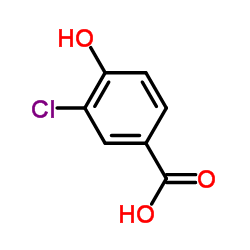3-Chloro-4-hydroxybenzoic acid

3-Chloro-4-hydroxybenzoic acid structure
|
Common Name | 3-Chloro-4-hydroxybenzoic acid | ||
|---|---|---|---|---|
| CAS Number | 3964-58-7 | Molecular Weight | 172.566 | |
| Density | 1.5±0.1 g/cm3 | Boiling Point | 330.5±27.0 °C at 760 mmHg | |
| Molecular Formula | C7H5ClO3 | Melting Point | 171-173 °C(lit.) | |
| MSDS | Chinese USA | Flash Point | 153.7±23.7 °C | |
| Symbol |

GHS07 |
Signal Word | Warning | |
|
Solvent proton magnetic resonance dispersion in protocatechuate 3,4-dioxygenase and complexes with 3-halo-4-hydroxybenzoate inhibitors.
Biochemistry 23(17) , 3955-9, (1984) Solvent proton nuclear magnetic dispersion studies at 25, 100, and 300 MHz have been performed on protocatechuate 3,4-dioxygenase (PCD) and its complexes with 3-chloro-4-hydroxybenzoate and 3-fluoro-4-hydroxybenzoate. Longitudinal and transverse relaxation ra... |
|
|
Stimulation of aryl metabolite production in the basidiomycete Bjerkandera sp. strain BOS55 with biosynthetic precursors and lignin degradation products.
Appl. Environ. Microbiol. 63(5) , 1987-94, (1997) Aryl metabolites are known to have an important role in the ligninolytic system of white rot fungi. The addition of known precursors and aromatic acids representing lignin degradation products stimulated the production of aryl metabolites (veratryl alcohol, v... |
|
|
Fraction of electrons consumed in electron acceptor reduction and hydrogen thresholds as indicators of halorespiratory physiology.
Appl. Environ. Microbiol. 65(9) , 4049-56, (1999) Measurements of the hydrogen consumption threshold and the tracking of electrons transferred to the chlorinated electron acceptor (f(e)) reliably detected chlororespiratory physiology in both mixed cultures and pure cultures capable of using tetrachloroethene... |
|
|
Characterization of Desulfitobacterium chlororespirans sp. nov., which grows by coupling the oxidation of lactate to the reductive dechlorination of 3-chloro-4-hydroxybenzoate.
Appl. Environ. Microbiol. 62(10) , 3800-8, (1996) Strain Co23, an anaerobic spore-forming microorganism, was enriched and isolated from a compost soil on the basis of its ability to grow with 2,3-dichlorophenol (DCP) as its electron acceptor, ortho chlorines were removed from polysubstituted phenols but not ... |
|
|
The anaerobic degradation of 3-chloro-4-hydroxybenzoate in freshwater sediment proceeds via either chlorophenol or hydroxybenzoate to phenol and subsequently to benzoate.
Appl. Environ. Microbiol. 58(11) , 3580-5, (1992) To study the anaerobic degradation of the chimera 3-chloro-4-hydroxybenzoate (3-Cl,4-OHB), anaerobic freshwater sediment samples from the vicinity of Athens, Ga., were adapted for the transformation of 4-hydroxybenzoate (4-OHB), 3-chlorobenzoate (3-CB), 2-chl... |